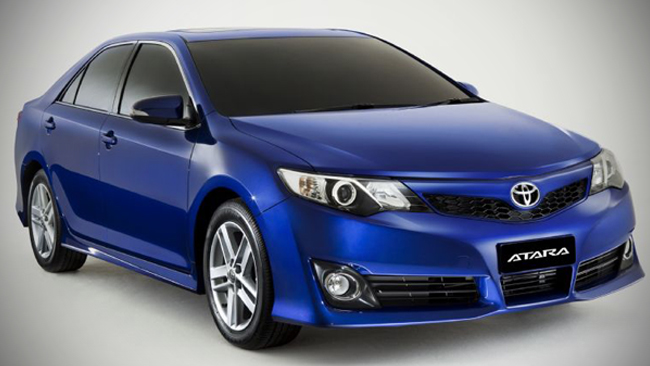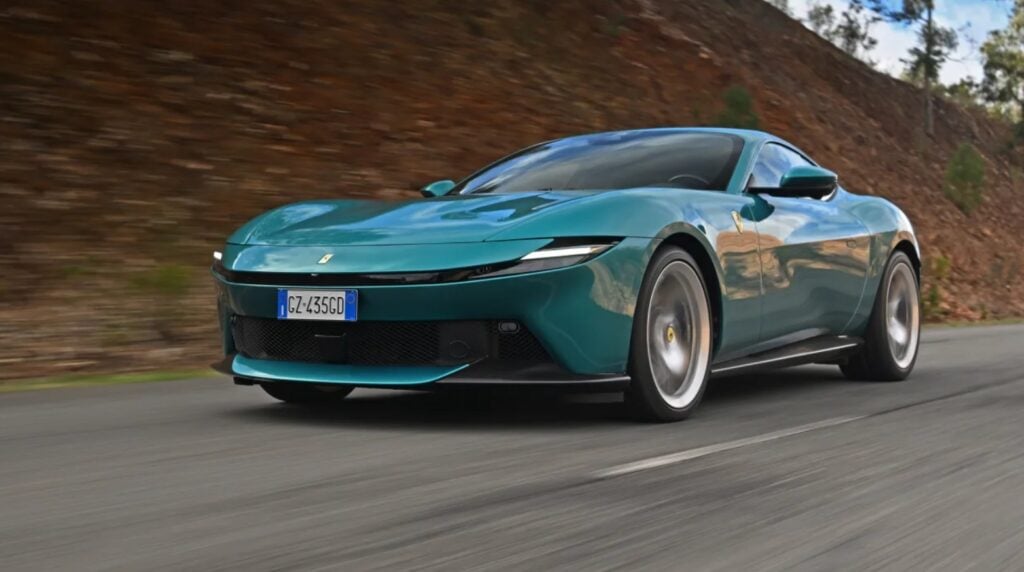TOYOTA will be targeting private and novated lease buyers as well as the usual fleet operators in a much bigger way than it ever has before with the new Atara version of its seventh-generation Camry sedan.
To be positioned as a ‘premium’ luxury version of the completely redesigned midsizer when launched in the last week of November, the Atara (Hebrew for ‘crown’ – which is funny since Camry is a derivation of the Japanese word‘atarashii’ which also means crown!) will boast a sportier nose with mesh grille inserts and a three-piece bumper design to differentiate it from the bread and butter Altise.
Five-spoke alloys, a small boot spoiler, and dual exhaust outlets further underline Toyota’s intent against more driver-orientated rivals like the Honda Accord Euro, Mazda6 and Ford Mondeo.
Power and torque outputs that are “slightly above” the respective 10 and five per cent improvements the new 2.5-litre four-cylinder petrol engine offers over the outgoing model’s 117kW/218Nm 2.4-litre unit are also promised as a result of the revised exhaust system, to give the Atara a few more herbs and spices underneath that pedestrian-friendly bonnet.
Along with a new six-speed automatic gearbox complete with a Tiptronic-style sequential shift pattern, and a circa-70kg weight saving across the range as a result of a move to lighter higher-tensile steels, the Mk7 Camry ought to feel more energetic than the current five-year old version.
A drop of approximately 10 per cent in the average combined fuel consumption figure compared to today’s Camry auto’s 9.5L/100km has also been flagged, aided by a sleeker silhouette featuring specific airflow improvements in areas such as the side mirrors and tail-lights, as well as some concentrated aerodynamic work underneath the newcomer.
In fact, along with “100 per cent new sheetmetal”, more than 90 per cent of the Camry is described as “all new” overall.
Of the many improvements brought upon the latest model, the company is making the loudest noises about how much quieter Camry 7 is, particularly in terms of the noise articulation index – or how easily passengers can converse inside the car.
Speaking of the cabin, a sizeable 15mm gain in the ‘couple distance’ (the length between the hip points of the peeps in the front and rear seats) has been achieved as a result of moving the dash, steering and front seat 7mm forward and the rear seat 8mm back. Scalloping out the rear seats and using thinner cushions have also helped increase interior space in a package that is basically the same size as before.
An Australian-specific addition to the range, the Atara’s stylistic differences were incorporated into the early design stages of the new Camry’s development in Japan, according to Toyota Style Australia styling and design manager, Paul Beranger, and will be included in the sporty version of the car in its US Sport guise.
“Overall is shows that (Toyota) Australia’s voice is disproportionally louder than the six per cent or so of total global sales of Camry in this country,” Mr Beranger said. “Japan is very open and accepting to our inputs.”
More Australian input will be prevalent in the new Camry’s interior presentation and trim, which will differ in detail rather than overall design from the vehicles sold elsewhere in the world. What exactly these changes are will not be revealed until launch time, however (shown here is the overseas-spec cabin).
“We will need something to titillate you with!” says Toyota Motor Company Australia sales and marketing boss David Buttner.
Thoughts about what Australians would like in their next Camry started even before the current version’s 2009 facelift was executed during 2007, while the engineers and designers got down to it in Japan in 2008.
With over 70 per cent of total Altona (Melbourne) production of Camry currently headed to 17 nations across the world including New Zealand and Saudi Arabia, that Australian input also takes into account the needs of Toyota’s key export customers.
Although no more specification, mechanical, or model details will be released until the national launch, Toyota has confirmed that the 2.5-litre drivetrain will initially be imported from Japan, before the $300 million Altona engine plant upgrade comes on line late in 2012.
Before that there will also be a Camry Hybrid version out early next year, as well as the second-generation Aurion sedan – the V6 petrol Camry sporting a different nose and tail – out in April or May 2012.
The Camry has been number one in its medium car segment for 17 consecutive years in Australia, with over 750,000 units sold since Altona started building the second-generation sedan and wagon in early 1987. When the 850,000 exports since 1996 are included, the total figure produced tops 1.6 million cars.
The United States consumes around 50 per cent of all Camry production, with one fifth going to China. Surprisingly enough, Australia is the third biggest market, with just over 36,700 units sold in 2010 – although 11,764 of those were actually Aurions. Adding the 70,000 Camrys exported, total Altona production topped 105,000 cars last year.
Described as Toyota’s “backbone” model, over 15 million Camrys have been sold in over 100 countries since the series was first unveiled as the F-150 concept car at the 1981 Tokyo Motor Show. Australian sales commenced in 1983 – as a premium alternative to the very humdrum Corona of the day. Atara, then, aims to go full circle.
As WHEELS January 1982 cover predicted, that first Camry was “Toyota’s Secret Weapon” that could go on to “change the face of motoring”….





